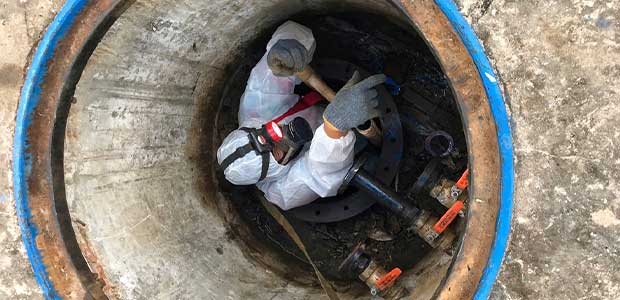
Five Tips to Improve Safety in Confined Spaces
When workers in confined spaces need your help, you can’t act on impulse.
- By Ryan Thompson
- May 01, 2022
A lot can happen in four minutes, especially when those four minutes are spent in a confined space.
Confined spaces are prone to oxygen displacement, and just four minutes without oxygen can cause brain damage or even death. It should be no surprise, then, that confined spaces are the leading cause of multiple fatalities in the workplace. That’s why it’s so important to take extra precautions to ensure entrants and hole watches are trained on how to safely work in and around confined spaces.
You’ve heard the story dozens of times: a worker enters a confined space, often for routine maintenance or repair, and is overcome by an atmospheric hazard. When the entrant doesn’t respond to the hole watch, their supervisor and peers get worried, so one of them enters the confined space to check on the original entrant only to be overcome by the same gas hazard. Unfortunately, this scenario is too common—The National Institute for Occupational Safety and Health (NIOSH) reports that 60 percent of confined space deaths are among these “would-be” rescuers who enter a confined space without understanding the hazards within, only to fall victim to the same hazard.
When someone around you is in danger, your instinct is to help. In some cases, this behavior is helpful, like when you catch a toddler before he falls and hits his head. Unfortunately, there are plenty of times when this behavior can make a dangerous situation even more dire. For example, even though you have good intentions, slamming on your car’s brakes or swerving to avoid hitting a squirrel or other small animal in the road could cause a dangerous multi-car pileup.
While you always want to act swiftly, it must be balanced to ensure that the actions you take to help others won’t cause further harm to yourself or other people around you.
What you do and how you decide to do it can make the difference between a regular day on the job and tragedy—especially when working around confined spaces.
When workers in confined spaces need your help, you can’t act on impulse—you need to be prepared with a plan in place long before the first worker enters a confined space.
When creating a confined space entry plan, there are five best practices to keep in mind to help everyone make it home safely.
Step 1: Have a Plan
Make sure you understand the confined space regulations in your region, then document the steps everyone needs to take before, during and after a confined space entry.
This article originally appeared in the May 2022 issue of Occupational Health & Safety.